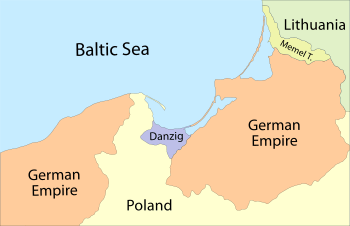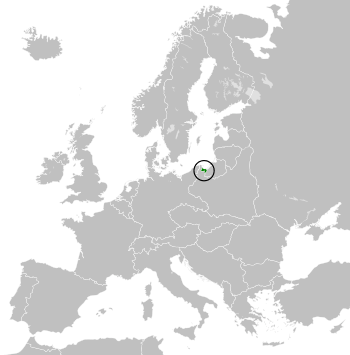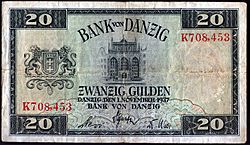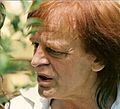Free City of Danzig facts for kids
Quick facts for kids
Free City of Danzig
|
|||||||||
|---|---|---|---|---|---|---|---|---|---|
| 1920–1939 | |||||||||
|
Motto: "Nec Temere, Nec Timide"
|
|||||||||
|
Anthem: Für Danzig / Gdańsku
|
|||||||||

Danzig, surrounded by Germany and Poland
|
|||||||||

Location of the Free City of Danzig in 1930s Europe
|
|||||||||
| Status | Free City under League of Nations protection | ||||||||
| Capital | Danzig | ||||||||
| Common languages | |||||||||
| Religion | |||||||||
| Government | Republic | ||||||||
| High Commissioner | |||||||||
|
• 1919–1920
|
Reginald Tower | ||||||||
|
• 1937–1939
|
Carl Jacob Burckhardt | ||||||||
| Senate President | |||||||||
|
• 1920–1931
|
Heinrich Sahm | ||||||||
|
• 1934–1939
|
Arthur Greiser | ||||||||
| Legislature | Volkstag | ||||||||
| Historical era | Interwar period | ||||||||
|
• Independence from Germany
|
15 November 1920 | ||||||||
| 1 September 1939 | |||||||||
|
• Annexed by Germany
|
2 September 1939 | ||||||||
| Area | |||||||||
| 1923 | 1,966 km2 (759 sq mi) | ||||||||
| Population | |||||||||
|
• 1923
|
366730 | ||||||||
| Currency |
|
||||||||
|
|||||||||
| Today part of | |||||||||
The Free City of Danzig (German: Freie Stadt Danzig; Polish: Wolne Miasto Gdańsk) was a special self-governing port city. It was located on the Baltic Sea. It was created on January 10, 1920, after World War I.
This happened because of the Treaty of Versailles in 1919. The city was placed under the protection of the League of Nations. Poland was given special rights there. This was because Danzig was the only major port in the Polish Corridor.
The Free City stopped existing in 1939. It was taken over by Nazi Germany. After Germany lost World War II in 1945, Danzig became part of Poland. Today, it is known by its Polish name, Gdańsk.
Contents
How the Free City of Danzig Was Set Up
Land and Area
The Free City of Danzig included the main city of Danzig. It also had other towns like Zoppot (Sopot) and Tiegenhof (Nowy Dwór Gdański). Many villages and small settlements were also part of it.
The total area of the Free City was about 1,966 km2 (759.1 sq mi).
Poland's Special Rights
Even though Danzig was a Free City, Poland had some important rights there. Poland's ambassadors represented the Free City in other countries. The railway line connecting Danzig to Poland was managed by Poland.
Also, a military post called the Westerplatte was given to Poland. This was a former city beach. There were also two post offices in the city. One was for Danzig's own postal service, and the other was run by Poland.
Leaders from the League of Nations
The League of Nations was an organization that promoted peace. It oversaw the Free City of Danzig. Different people from various countries served as "High Commissioners." They acted as representatives for the League of Nations in Danzig.
Here are some of the High Commissioners:
- Reginald Thomas Tower from the
 UK (1919-1920)
UK (1919-1920) - Edward Lisle Strutt from the
 UK (1920)
UK (1920) - Bernardo Attolico from
 Italy (1920)
Italy (1920) - Richard Cyril Byrne Haking from the
 UK (1921-1923)
UK (1921-1923) - Mervyn Sorley McDonnell from the
 UK (1923-1925)
UK (1923-1925) - Joost Adriaan van Hamel from the
 Netherlands (1925-1929)
Netherlands (1925-1929) - Manfredi di Gravina from
 Italy (1929-1932)
Italy (1929-1932) - Helmer Rosting from
 Denmark (1932-1934)
Denmark (1932-1934) - Seán Lester from the
 Irish Free State (1934-1936)
Irish Free State (1934-1936) - Carl Jakob Burckhardt from
 Switzerland (1937-1939)
Switzerland (1937-1939)
People Living in Danzig
In 1919, about 357,000 people lived in the Free City. Most of them, about 98%, spoke German. The rest mainly spoke Kashubian or Polish.
The Treaty of Versailles changed who was a citizen. People living in Danzig became citizens of the Free City. If Germans wanted to keep their German nationality, they had to move outside Danzig.
Danzig's Government and Politics
The Free City of Danzig had its own government. The main leaders were called "Presidents of the Danzig Senate."
Here are some of the leaders:
- Heinrich Sahm (1920-1931)
- Ernst Ziehm (1931-1933) from the DNVP
- Hermann Rauschning (1933-1934) from the NSDAP Party
- Arthur Karl Greiser (1934-1939) from the NSDAP Party
- Albert Förster (1939) from the NSDAP Party
In May 1933, the Nazi Party won local elections in Danzig. They tried to change the city's rules. They introduced unfair laws against Jewish people and also against Polish and Kashubian residents.
Poland did not want Danzig's special status to change. In April 1939, Poland said it was ready to fight if the status of Danzig was altered.
End of the Free City and Aftermath
The Nazi government in Danzig voted to rejoin Germany on September 2, 1939. This was the day after Germany invaded Poland.
By the end of World War II, about 90% of Danzig was destroyed. On March 30, 1945, the city was taken by the USSR. It is believed that most of the people who lived there before the war had either died or left by 1945.
At the Potsdam Conference, the Allied Powers decided that the former Free City would become part of Poland. This decision made it clear that Danzig would not be a Free City again.
Related Pages
- Gdańsk
- Danzig Corridor
Images for kids
-
Population density of Poland and the Free City of Danzig (Gdańsk) in 1930
See also
 In Spanish: Ciudad Libre de Dánzig para niños
In Spanish: Ciudad Libre de Dánzig para niños


















